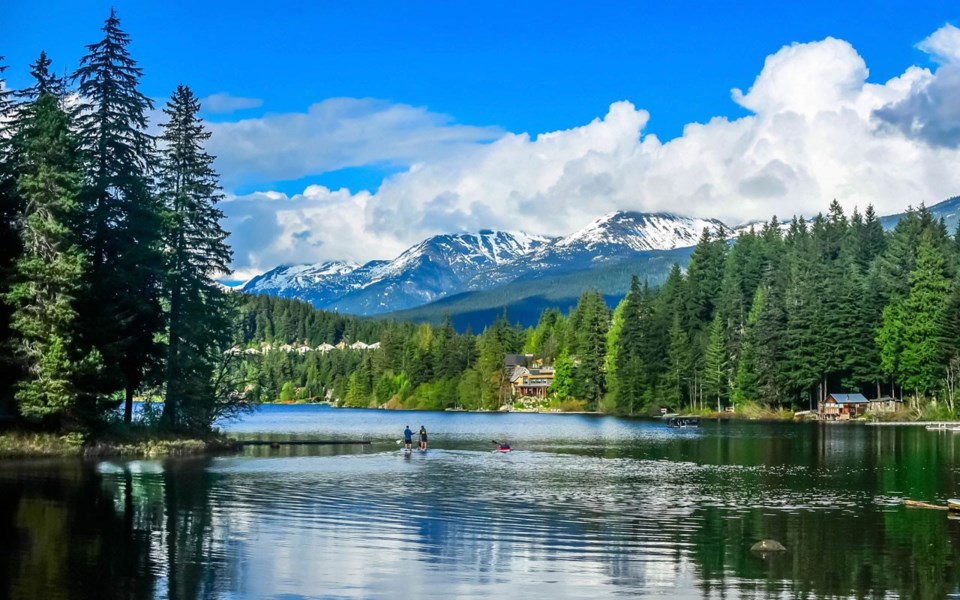It's the dead of winter and the other three seasons are but a frozen memory here in Whistler. But since the folks who designate International Days of Everything pay no heed to hemispheric seasonality, you're forgiven if you somehow missed marking down Feb. 2 in your when calendar as World Wetlands Day (though in the aftermath of the January-ending rainstorm that preceded it, you may well have been dealing with a de facto wetland in your own yard).
As with other designations of this sort, World Wetlands Day highlights something of global importance that requires more of our collective attention. Thus, the first question: Why are wetlands so important?
The list of answers is topped by this startling fact: these highly productive ecosystems where terrestrial and aquatic habitats meet cover only seven per cent of the planet, yet contain 40 per cent of the world's biodiversity. About a million species of plants and animals (e.g., molluscs, crustaceans, fish, amphibians, reptiles—particularly turtles and crocodilians—water birds and mammals) that live or breed in wetlands are threatened with extinction. Thus, loss of wetlands equals a net loss of biodiversity, while preserving or restoring them equals a hedge against this.
Wetlands are also a huge carbon sink—a natural solution to the effects of climate change and a support mechanism for a wide range of ecosystems. Mangrove and estuary wetlands that shield coastal areas from storms and floods sequester 50 times more carbon than tropical forests, and 30 per cent of land-based carbon is stored in bog peatlands. Swamps and marshes act as filters, cleaning water by removing pollutants and sediment. As natural sponges, wetlands both store and slowly release rainwater as a control against flooding and drought. In fact, wetlands annually provide US$47 trillion in essential services around the world, where a billion people depend on them for their food, water and livelihoods.
And yet, despite their obvious utility and key roles, wetlands continue to disappear globally three times faster than forests; 87 per cent gone since 1700—a shocking 35 per cent in the past 45 years. Key drivers of wetland loss include land conversion (drainage and infilling) and pollution. In the U.S., the environmentally criminal conservative government of Donald Trump recently reversed key tenets of the Clean Water Act that had protected wetlands, and Doug Ford's inept and uninformed "open for business" Conservative government in Ontario has made similar overtures.
Here in Whistler, 75 to 80 per cent of the valley's original wetlands have been lost to questionably planned development, so what remains should be considered functionally sacrosanct. And yet these continue to be abused: off-leash dogs root through fish-breeding areas in our lake parks, and invasive goldfish have been dumped into Millar's Pond and Pinecrest, Alpha, Nita and Alta Lakes—an ecological scourge given that goldfish eat the eggs and young of amphibians and both native and stocked game fish in shoreline wetlands.
I've spent a lot of time in wetlands, whether as a kid observing frogs and dragonflies, a graduate student studying salamanders, a canoeist making my way from lake to river to lake, or a science writer chasing a climate change or invasive species story, and what always captivates me most is their diversity. Words like swamp, marsh, bog and fen tend to be conflated in popular parlance, but each has its own definition based on chemistry, hydrology, seasonality and vegetation, and thus its own role to play.
Some of the world's most amazing wetlands are those that come and go from the landscape. The Okavango Delta in Botswana, for instance, a blind river mouth that floods a vast landscape once a year, is seasonal home to an enormous variety of wildlife and also a popular tourist attraction.
More permanent wetlands act as key waypoints in migratory pathways—like Saskatchewan's Chaplin/Old Wives/Reed Lakes area right on the TransCanada Highway, part of the Western Hemisphere Shorebird Reserve Network and one of the most important migratory bird sites in North America. Spanning 42,000 hectares, it includes the second largest inland saline water body in Canada where, each summer, over 30 shorebird species either nest or make a stop en route to the Arctic.
Scientists have long since come around to the Indigenous viewpoint that everything living is interconnected and has a purpose within that nexus. We need to educate from the earliest levels about such ecological thinking, whose prime directive is to support all species (and thus, their "function") in order to maintain balance in nature. Rather than thinking about them one day a year, actively respecting and protecting wetlands and their wildlife year-round would go a long way to achieving that.
Leslie Anthony is a science/environment writer and author who holds a doctorate in connecting the dots.




